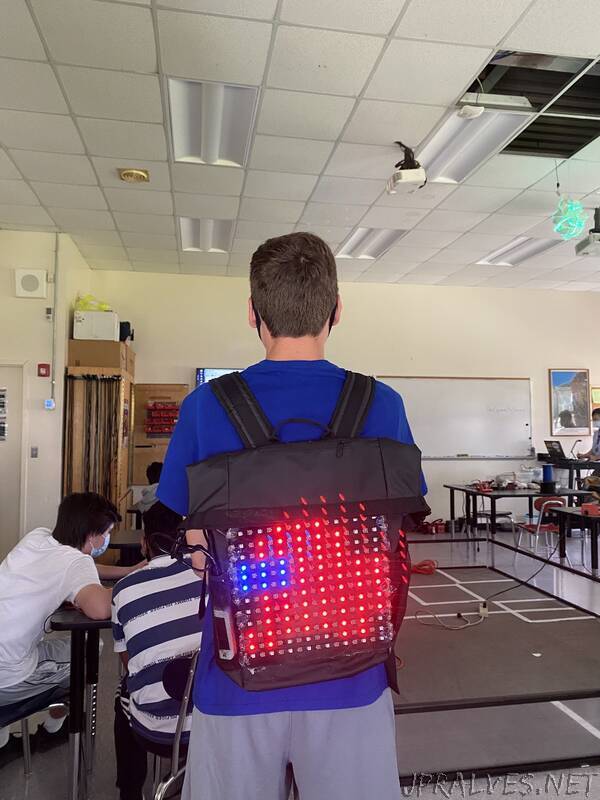
“A neo-pixel displaying the among us character which I then attached to a backpack.
Goal/ Requirements
While making the Among Us backpack there were a couple goals that had to be met, including:
It had to be light enough for me to carry it on my back
It had to be able to fit on my backpack
It had to be bright enough to be seen even in the day
It had to have a power source that was both portable and able to produce enough volts and amps to meet the second requirement (about 5V 1A)
The project had to be able to run for long amounts of time without overheating
The project had to display the lights in a way so that it was easy to recognize it as the among us character.
Before starting the project in person, I originally used tinkercad in order to make my first prototypes. Initially I made the project on an 8 by 8 grid, however this broke my last requirement as the character was very short and distorted. I also made a blue background which made it even harder to see. I compromised for this by making my second draft without the background and on a 12 by 12 grid, however after measuring the bag I planned on using I realized this broke my second requirement as the grid was too fat to fit on my bag. Luckily, I realized that my 12 by 12 code only used 8 rows anyway, so I switched to an 8 by 12 grid and tweaked the code to get an among us character that was both recognizable and able to fit on my bag.
Preliminary Design
Before I assembled the neopixels in person, I realized one more flaw with my prototypes. The neopixel strips were oriented so that I would have to run wires across the board between every row. To solve this problem I redid the simulation one last time and flipped every other row. This allowed me to keep all the wires on one side of the board. After this I measured the dimensions of my bag (mine was about 10.5 by 12) and cut out a piece of plastic to match these dimensions. This piece of plastic offered me an easier way to attach my neopixels to the project, along with a sturdy location for the neopixels to stay on to ensure they don’t bend too much. I used a laser cutter to cut out the piece of plastic to the size I needed and used glue to attach all the neopixel strips to the plastic.
Prototypes
After I attached the neopixels to the plastic, I soldered the wires to the nodes using different color wires (red for power, black for ground, and blue for data). Once all the wires were attached, I downloaded my code onto my arduino and tested the board to make sure it worked (luckily it did first try). Before attaching it to my bag, I also hot glued all of the wires in place to make sure they won’t get caught on anything or come undone. After all this, I finally hot glued the board to my bag.
The project worked just as I planned it first try! It felt just as light as a normal bag and caught everyone in the rooms attention. The arduino and power source were both able to fit in the bag no problem. Everything worked perfectly, however I knew I could still make it better.
Testing
No matter which output pin I used for power the arduino would heat up after powering the grid for too long. This went against my fifth requirement. This lead me to make a modification to the wiring. At this point in time, I had a USB cord plugged into the power source, which connected to the arduino, which would then power the grid (they were in series). To avoid heating up the arduino, I cut open the USB and rewired it so that the arduino and grid were in series. While doing this I realized that my USB’s color code was off, and for some reason the black wire was power and the red was ground. I carefully took note of this and wired two T joints for the two power cables, and then just wired the two information cables back together. This modification worked and the arduino no longer heats up at all.
Revisions
While this wasn’t necessarily a flaw in the project, it was only able to light up red. This became boring and repetitive. I decided that I would add more colors, so I added all the colors from among us I could (I couldn’t add black or brown because I used RGB neo-pixels, and I didn’t make lime or cyan because they were too similar to blue and green) I had the colors change in a loop using an array, and with some trial and error the backpack now cycles through 8 different colors of among us characters. An unforeseen benefit of this is that the bag is so bright it can be essential a portable disco ball in a dark room (I tested it)”
